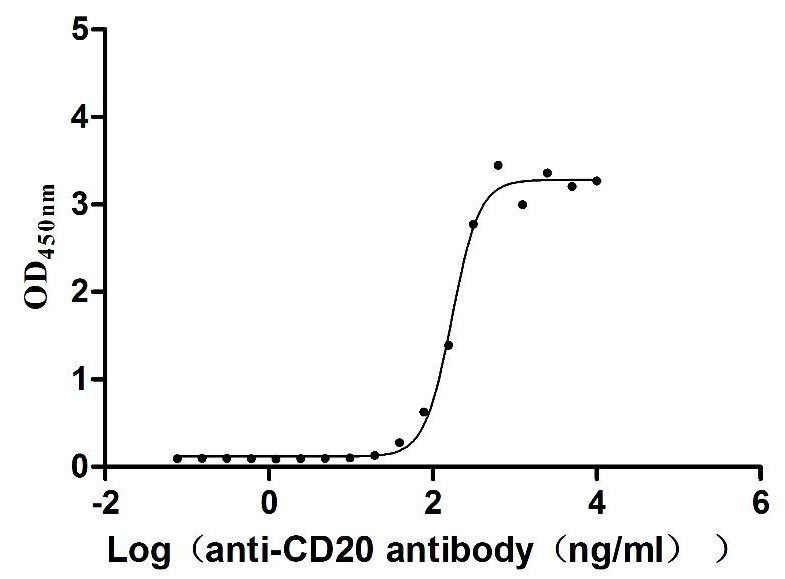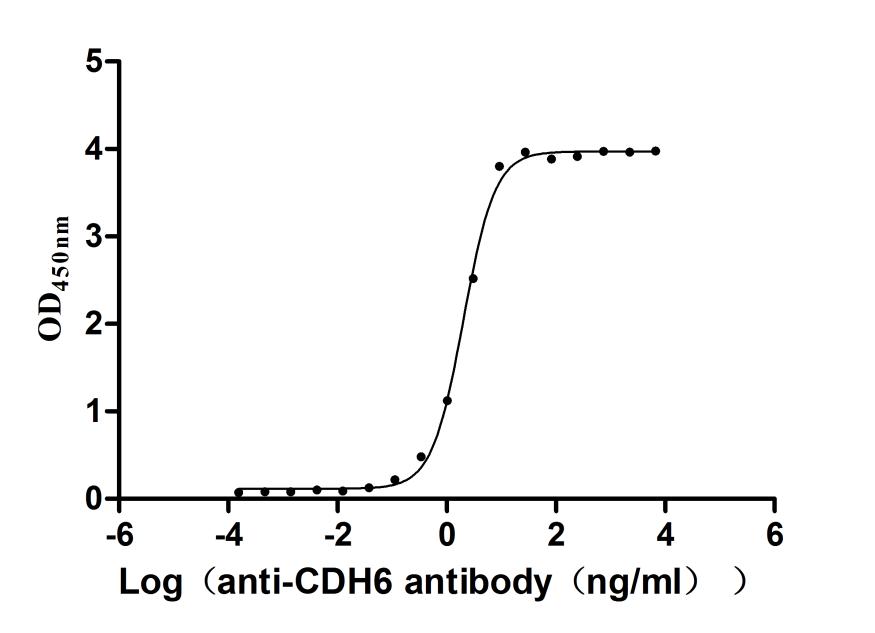Recombinant Mouse Huntingtin-associated protein 1 (Hap1)
-
货号:CSB-YP010129MO
-
规格:
-
来源:Yeast
-
其他:
-
货号:CSB-EP010129MO
-
规格:
-
来源:E.coli
-
其他:
-
货号:CSB-EP010129MO-B
-
规格:
-
来源:E.coli
-
共轭:Avi-tag Biotinylated
E. coli biotin ligase (BirA) is highly specific in covalently attaching biotin to the 15 amino acid AviTag peptide. This recombinant protein was biotinylated in vivo by AviTag-BirA technology, which method is BriA catalyzes amide linkage between the biotin and the specific lysine of the AviTag.
-
其他:
-
货号:CSB-BP010129MO
-
规格:
-
来源:Baculovirus
-
其他:
-
货号:CSB-MP010129MO
-
规格:
-
来源:Mammalian cell
-
其他:
产品详情
-
纯度:>85% (SDS-PAGE)
-
基因名:Hap1
-
Uniprot No.:
-
别名:Hap1; Huntingtin-associated protein 1; HAP-1
-
种属:Mus musculus (Mouse)
-
蛋白长度:Full length protein
-
表达区域:1-628
-
氨基酸序列MRPKEQVQSG AGDGTGSGDP AAGTPTTQPA VGPAPEPSAE PKPAPAQGTG SGQKSGSRTK TGSFCRSMII GDSDAPWTRY VFQGPYGPRA TGLGTGKAEG IWKTPAAYIG RRPGVSGPER AAFIRELQEA LCPNPPPTKK ITEDDVKVML YLLEEKERDL NTAARIGQSL VKQNSVLMEE NNKLETMLGS AREEILHLRK QVNLRDDLLQ LYSDSDDDDD EEDEEDEEEG EEEEREGQRD QDQQHDHPYG APKPHPKAET AHRCPQLETL QQKLRLLEEE NDHLREEASH LDNLEDEEQM LILECVEQFS EASQQMAELS EVLVLRLEGY ERQQKEITQL QAEITKLQQR CQSYGAQTEK LQQMLASEKG IHSESLRAGS YMQDYGSRPR DRQEDGKSHR QRSSMPAGSV THYGYSVPLD ALPSFPETLA EELRTSLRKF ITDPAYFMER RDTHCREGRK KEQRAMPPPP AQDLKPPEDF EAPEELVPEE ELGAIEEVGT AEDGQAEENE QASEETEAWE EVEPEVDETT RMNVVVSALE ASGLGPSHLD MKYVLQQLSN WQDAHSKRQQ KQKVVPKDSP TPQQQTNMGG GILEQQPRVP TQDSQRLEED RATHSPSARE EEGPSGAT
-
蛋白标签:Tag type will be determined during the manufacturing process.
The tag type will be determined during production process. If you have specified tag type, please tell us and we will develop the specified tag preferentially. -
产品提供形式:Lyophilized powder
Note: We will preferentially ship the format that we have in stock, however, if you have any special requirement for the format, please remark your requirement when placing the order, we will prepare according to your demand. -
复溶:We recommend that this vial be briefly centrifuged prior to opening to bring the contents to the bottom. Please reconstitute protein in deionized sterile water to a concentration of 0.1-1.0 mg/mL.We recommend to add 5-50% of glycerol (final concentration) and aliquot for long-term storage at -20℃/-80℃. Our default final concentration of glycerol is 50%. Customers could use it as reference.
-
储存条件:Store at -20°C/-80°C upon receipt, aliquoting is necessary for mutiple use. Avoid repeated freeze-thaw cycles.
-
保质期:The shelf life is related to many factors, storage state, buffer ingredients, storage temperature and the stability of the protein itself.
Generally, the shelf life of liquid form is 6 months at -20°C/-80°C. The shelf life of lyophilized form is 12 months at -20°C/-80°C. -
货期:Delivery time may differ from different purchasing way or location, please kindly consult your local distributors for specific delivery time.Note: All of our proteins are default shipped with normal blue ice packs, if you request to ship with dry ice, please communicate with us in advance and extra fees will be charged.
-
注意事项:Repeated freezing and thawing is not recommended. Store working aliquots at 4°C for up to one week.
-
Datasheet :Please contact us to get it.
靶点详情
-
功能:Originally identified as neuronal protein that specifically associates with HTT/huntingtin and the binding is enhanced by an expanded polyglutamine repeat within HTT possibly affecting HAP1 interaction properties. Both HTT and HAP1 are involved in intracellular trafficking and HAP1 is proposed to link HTT to motor proteins and/or transport cargos. Seems to play a role in vesicular transport within neurons and axons such as from early endosomes to late endocytic compartments and to promote neurite outgrowth. The vesicular transport function via association with microtubule-dependent transporters can be attenuated by association with mutant HTT. Involved in the axonal transport of BDNF and its activity-dependent secretion; the function seems to involve HTT, DCTN1 and a complex with SORT1. Involved in APP trafficking and seems to facilitate APP anterograde transport and membrane insertion thereby possibly reducing processing into amyloid beta. Involved in delivery of gamma-aminobutyric acid (GABA(A)) receptors to synapses; the function is dependent on kinesin motor protein KIF5 and is disrupted by HTT with expanded polyglutamine repeat. Involved in regulation of autophagosome motility by promoting efficient retrograde axonal transport. Seems to be involved in regulation of membrane receptor recycling and degradation, and respective signal transduction, including GABA(A) receptors, tyrosine kinase receptors, EGFR, IP3 receptor and androgen receptor. Among others suggested to be involved in control of feeding behavior (involving hypothalamic GABA(A) receptors), cerebellar and brainstem development (involving AHI1 and NTRK1/TrkA), postnatal neurogenesis (involving hypothalamic NTRK2/TrkB regulating the number of Npyr1-expressing cells), and ITPR1/InsP3R1-mediated Ca(2+) release (involving HTT and possibly the effect of mutant HTT). Via association with DCTN1/dynactin p150-glued and HTT/huntingtin involved in cytoplasmic retention of REST in neurons. May be involved in ciliogenesiss; however, reports are conflicting: PubMed:21985783 reports that Hap1 is required for ciliogenesis in primary cortical neurons and proposes that HTT interacts with PCM1 through HAP1; PubMed:23532844 reports that mice with disrupted Hap1 display normal cilium formation and function. Involved in regulation of exocytosis. Isoform A but not isoform B seems to be involved in formation of cytoplasmic inclusion bodies (STBs). In case of anomalous expression of TBP, can sequester a subset of TBP into STBs; sequestration is enhanced by an expanded polyglutamine repeat within TBP.
-
基因功能参考文献:
- This study also validated the interaction between HAP1 and Sec23A using co-immunoprecipitation experiments with endogenous proteins. This manuscript also reports on the high confidence interacting partners of HAP1 identified by the non-biased approach used in this study, which interestingly, consists of predominantly trafficking-related proteins PMID: 28259758
- HAP1 co-localizes with synapsin I in cortical neurons as discrete puncta PMID: 27315547
- Early loss of Hap1 significantly reduces postnatal hippocampal neurogenesis, and leads to adult depressive-like behavior. PMID: 25875952
- Hap1 interacts with Bcr on microtubules to regulate neuronal differentiation. PMID: 25671650
- HAP1 regulates exocytosis by influencing the morphological docking of vesicles at the plasma membrane, the ability of vesicles to be released rapidly upon stimulation, and the early stages of fusion pore formation. PMID: 24366265
- these studies identify htt and HAP1 as regulators of autophagosome transport in neurons PMID: 24453320
- In the absence of HAP1, postnatal hypothalamic neurons exhibited reduced receptor tropomyosin-related kinase B (TRKB) levels. PMID: 24355921
- Hap1-Tsc1 interaction regulates neuronal mTORC1 signaling and neuronal morphogenesis. PMID: 24227713
- Mutant mice with Hap1 deficiency in pancreatic beta-cells had impaired glucose tolerance and decreased insulin release in response to intraperitoneally injected glucose. PMID: 21544547
- Loss of Htt impaired the retrograde trafficking of PCM1 and thereby reduced primary cilia formation. PMID: 21985783
- Results indicate that the Hap1-Ahi1 complex in the brainstem works as a sensor for insulin signals in feeding control. PMID: 21146532
- Hap1 is critical for the transport of multiple proteins to the nerve terminals to maintain the integrity of neuronal processes PMID: 20304926
- results demonstrate that HAP-1 plays an essential role in regulating postnatal feeding PMID: 11971876
- HAP-1 is highly expressed in hypothalamus. Mice lacking HAP1 die after birth because of depressed feeding. The effect of mutant huntingtin on HAP1 and EGFR signaling may contribute to hypothalamic neurodegeneration and weight loss in Huntington disease PMID: 12890790
- HAP1 facilitates potentiation of InsP3 receptor-1 mediated Ca2+ release. PMID: 15379999
- may be involved in protective pathways that contribute to the resistance of interneurons to neurodegeneration in HD. PMID: 15548548
- Results provide evidence linking hypothalamic Hap1 to GABA in the stimulation of feeding and suggest that this mechanism is involved in the feeding-inhibitory actions of insulin in the brain. PMID: 16604089
- phosphorylation-dependent interaction of HAP1A with 14-3-3 regulates HAP1 function by influencing its association with kinesin light chain and trafficking in neuronal processes. PMID: 17166838
- HAP1 can sequester a subset of TBP protein away from the nucleus; extranuclear TBP sequestration is quantitatively influenced by the TBP polyQ repeat. These results suggest HAP1 could provide protection from SCA17 neuropathology. PMID: 17868456
- Hap1 interacts with Ahi1 to regulate cerebellar and brainstem development in mice. PMID: 18636121
显示更多
收起更多
-
亚细胞定位:Cytoplasm. Cell junction, synapse, presynapse. Cytoplasm, cytoskeleton. Cell projection, dendritic spine. Cell projection, dendrite. Cell projection, axon. Lysosome. Endoplasmic reticulum. Mitochondrion. Nucleus. Cytoplasmic vesicle, autophagosome. Early endosome. Cell projection, growth cone.; [Isoform B]: Cytoplasm.; [Isoform A]: Cell projection, growth cone. Cell projection, neuron projection. Cytoplasmic vesicle, secretory vesicle, synaptic vesicle. Cell junction, synapse, presynapse.
-
数据库链接:
KEGG: mmu:15114
STRING: 10090.ENSMUSP00000133356
UniGene: Mm.281700
Most popular with customers
-
Recombinant Mouse Microtubule-associated protein tau (Mapt) (Active)
Express system: Mammalian cell
Species: Mus musculus (Mouse)
-
Recombinant Human Zymogen granule protein 16 homolog B (ZG16B) (Active)
Express system: Mammalian cell
Species: Homo sapiens (Human)
-
Recombinant Dog B-lymphocyte antigen CD20 (MS4A1)-VLPs (Active)
Express system: Mammalian cell
Species: Canis lupus familiaris (Dog) (Canis familiaris)
-
Recombinant Human Interleukin-2 receptor subunit alpha (IL2RA), partial (Active)
Express system: Mammalian cell
Species: Homo sapiens (Human)
-
Recombinant Human CD81 antigen (CD81), partial (Active)
Express system: Mammalian cell
Species: Homo sapiens (Human)
-
Recombinant Mouse Cadherin-6(Cdh6),partial (Active)
Express system: Mammalian cell
Species: Mus musculus (Mouse)


















